Ramp's Slack Integration
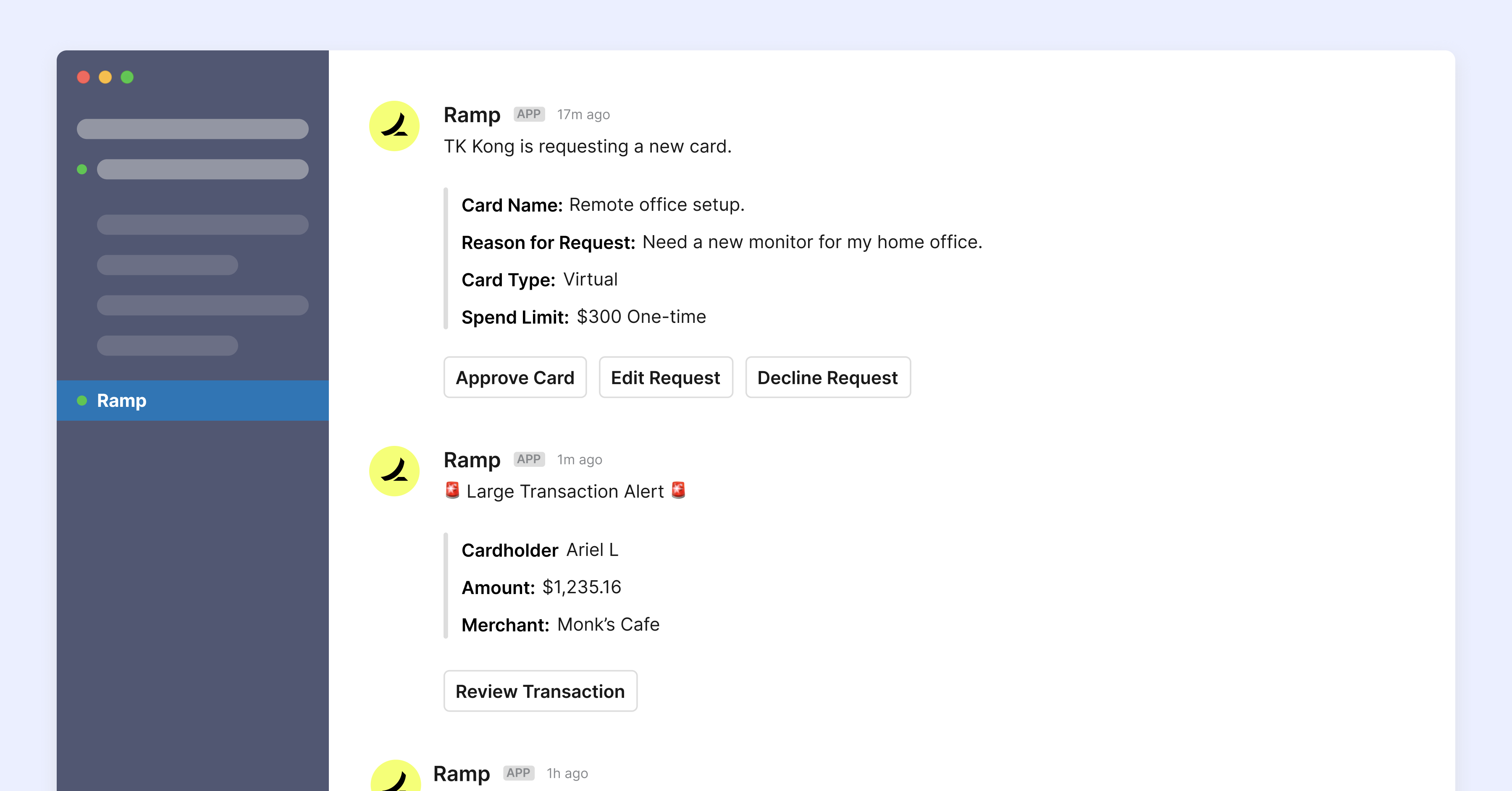
Ramp is a corporate card and expense management platform that helps companies spend less and save more time. As the corporate card industry's first Slack integration, we enabled teams to manage company spend and issue cards directly in Slack.
As the PM and designer on the project, I led a team of 3 from idea to launch in less than 3 months.
"We can approve new cards without leaving the conversation and I'm at ease knowing that any questionable transaction will instantly be brought to my attention." - Wes, COO at ClickUp ($1B+ valuation).
Overview
Problem
Speaking with finance teams and employees, we identified two pain points with the Ramp platform today.
As an employee, I ask for permission to spend money on software, travel, or benefits directly in Slack but once verbally approved, I have to log into the Ramp dashboard to fill out the details and formally request a card.
As an admin, I receive lots of emails in my inbox and it's easy to overlook requests for new cards. I want to easily approve cards and unblock company spending directly where I do work – Slack. I also want to receive other important business alerts so that I can triage and discuss with my finance team.
How might we...
- Provide peace of mind by sending alerts where finance teams and admins do work?
- Make it dumb easy to use Ramp features without having to log into the Ramp dashboard?
- Encourage discussions and create urgency around finances in channels to save companies money?
Business Value
- Increases activation – make it super easy for anyone at the company to request a card from Slack.
- Promote sense of control – finance teams can see real-time notifications they have configured.
- Promote saving time – we integrate directly where teams do work / discuss so that conversations are centralized.
- Stickiness – this will become part of the company's norm and will be harder to move away from something that you are used to.
- Customers want it – customers have asked for this and it's been a blocker for some sales conversations.
Team
We were a small team of 3:
Timeline
We had the kickoff meeting in mid-May and launched publicly on the Slack Marketplace on August 13, 2020.
Outcome
Usage metrics have been redacted for this work. If you'd like to learn more, message me at tk@tkkong.com
Features:
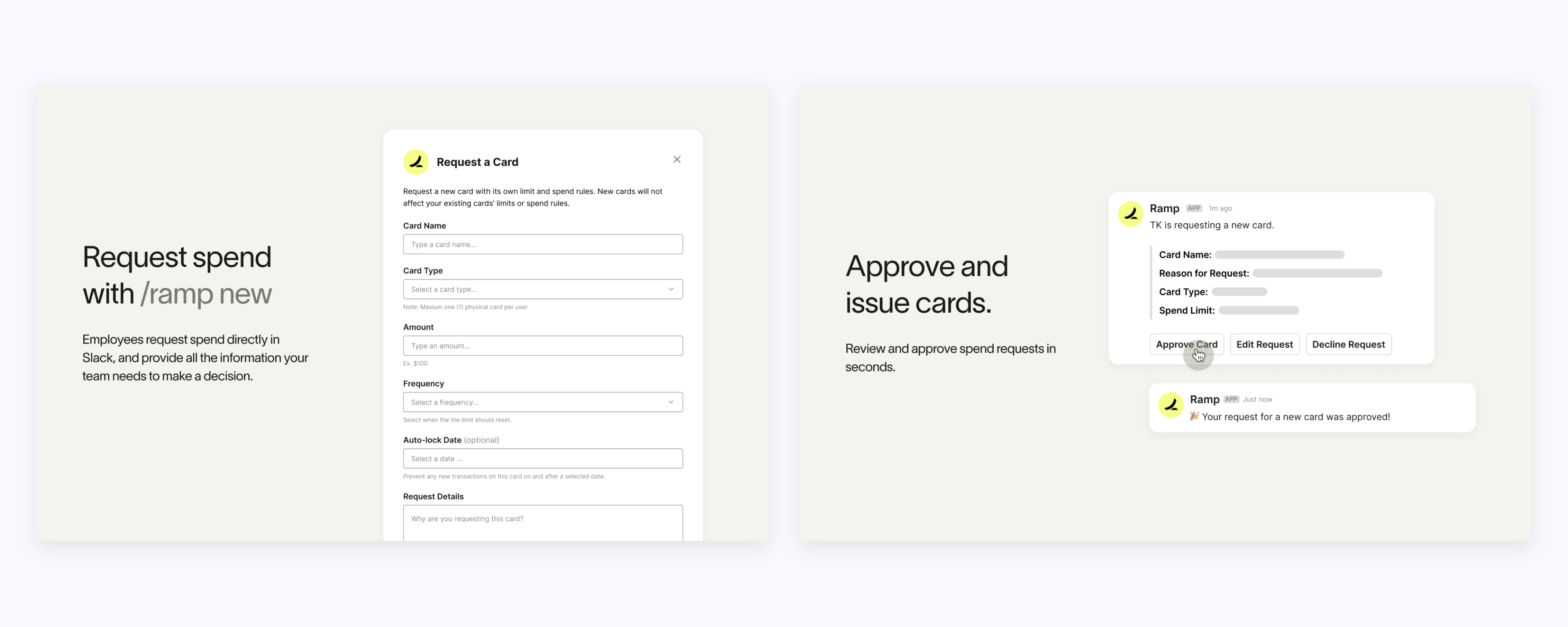
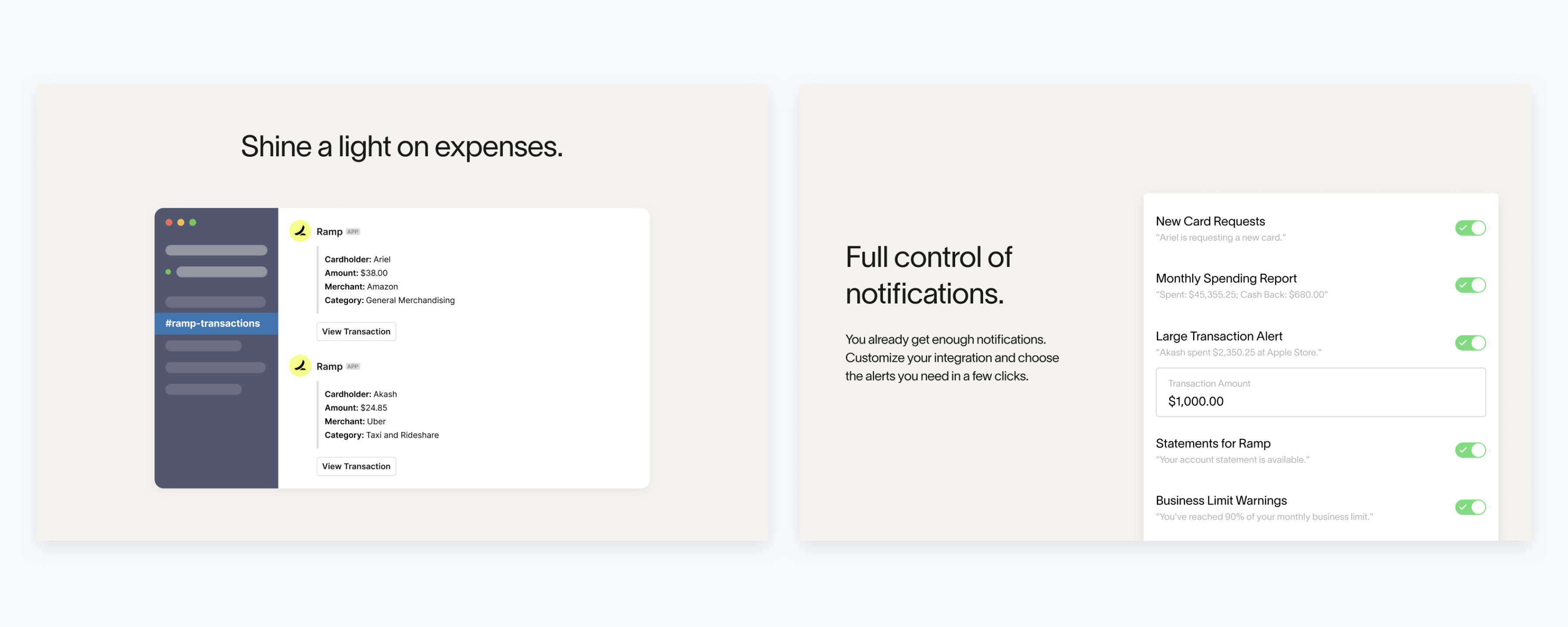
- Request spend with /ramp new slash command – employees can request spend directly in Slack, and provide all the information the team needs to make a decision.
- Approve and issue cards in seconds.
- Take action on important business alerts like new card requests, large transactions, limit warnings, and more.
- Stream all company expenses to create a culture of transparency and accountability.
- Gain full control of notifications to reduce spam and increase utility.
Product
Co-building with customers
We created a discovery deck and mocked up features that we thought might be valuable to our customers. We reached out to prospects and existing customers and asked for feedback. Key takeaways:
- People don't want to get spammed on Slack. Slack is where they do work and they want to have full control of notifications. This was an important learning for our team. We positioned marketing copy around this and created granular notification controls on the dashboard.
- Finance teams, especially startups, want to cultivate a culture of transparency and accountability. For example, NUGGS had hacked Brex (another corporate card platform)'s API to stream all company expenses into a public Slack channel. (After launching our integration, NUGGS switched over to Ramp.)
- Getting personal Ramp notifications like missing receipts and memos via Slack isn't as valuable. We decided to punt on this.
- Inviting users via a command in Slack is helpful but admins prefer to have directory syncs to easily add new employees. We also decided to punt on this and make this a later growth project.
Challenges
The biggest challenge with building the Slack integration was the edge cases and error handling. To deliver the best user experience, we had to map-out all the different cases. To name a few:
- If an employee clicks a button on a Slack message (e.g. new card request), we have to verify that they have permissions to review that card request.
- If an employee's Slack email address is different than the one associated with Ramp, we can't allow them to use the Ramp features in Slack. We created an error message so that they can easily go to the Ramp dashboard and input their Slack email address.
- If an admin wants to setup a private channel for business alerts, we had to instruct them to properly invite the Ramp Slackbot into that channel.
- We had to handle input errors in the Slack modals for creating new card requests.
- We also updated Slack messages to reflect the latest state (ex. approved / edited / rejected by X).
We ended up designing 40+ content types.
Launching, Marketing & PR
After testing flows and alerts from different user roles (admins, manager, employee, bookkeeper, no Ramp account), we were good to distribute the Slack app with our customers.
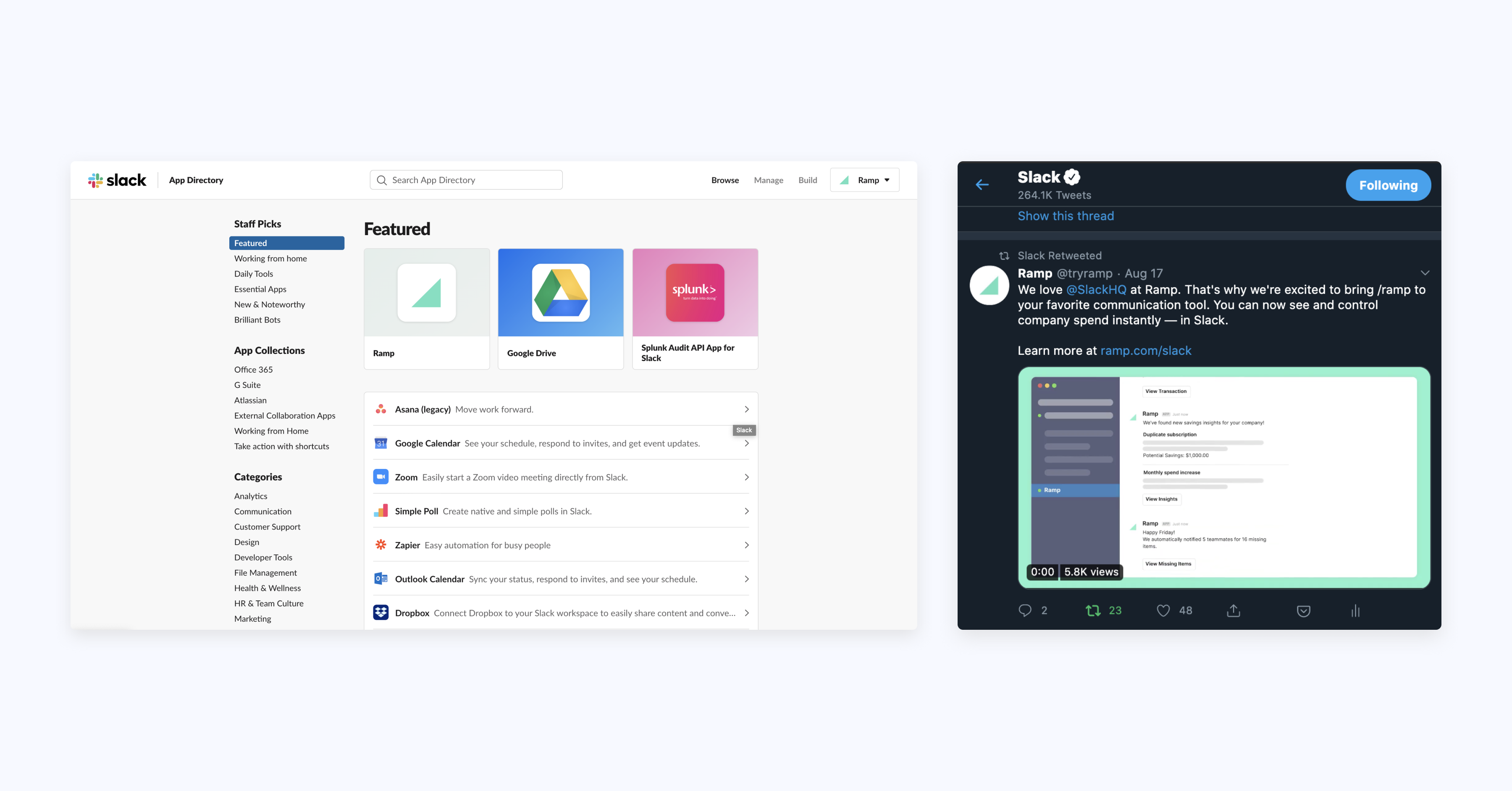
We partnered with the Slack Platform team to feature Ramp on the Slack App Marketplace and have Slack re-tweet our launch marketing.
We also built a landing page to story-tell and showcase our new Slack integration.
We received great interest from our launch! Afterward, Geoff, the Head of Product at Ramp and I sat down with the 11FS Homescreen team for a podcast on the Slack integration. Check out the episode below.
Lastly, Ramp's Slack integration was featured in our PR release in August 2020.
Customer Love
"An instant pulse-check of spending across the org and smart custom suggestions that save us money, in the place we spend the most time – our team Slack" - Brandon, VP of Operations at OnDeck.
"Seamlessly receiving real-time expense alerts has been a game-changer for our Finance team. The Ramp/Slack integration has drastically improved visibility and has resulted in better expense management and more accurate forecasting." - Evan, Head of Finance at nate.tech
"The Slack integration is a great feature because it provides information and options right where the entire team already is...in Slack. The tool at your fingertips is invaluable to transparency and adoption of Ramp." - Brock, Director of Finance at Physician's Choice.
And my favorite:
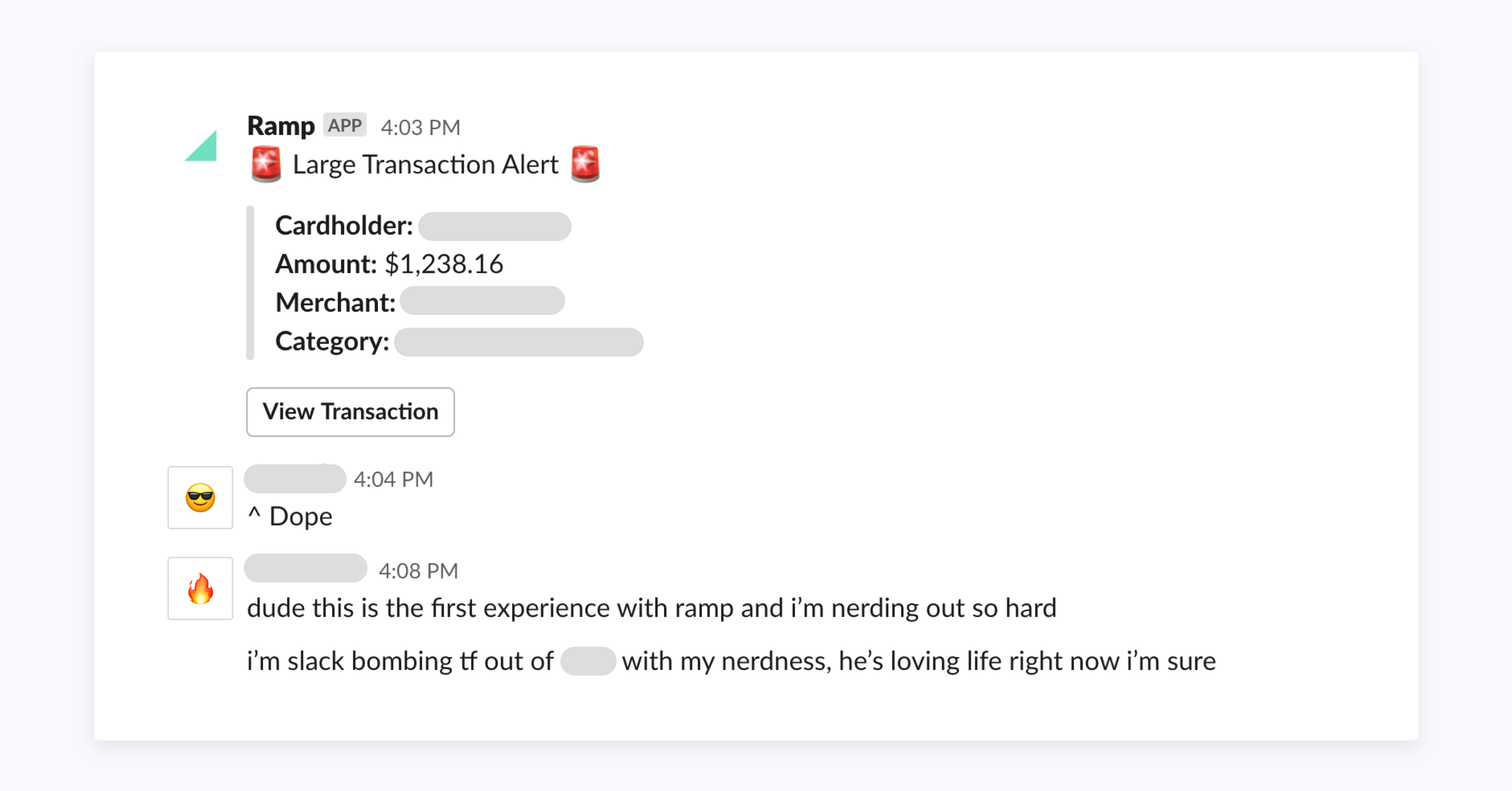
Impact
We brought on new customers who were excited about the Slack integration for seamless monitoring of company finances and easy user experience for employees to request spend. Existing customers loved the feature and mentioned it in our product surveys as a top feature release!
Learnings
- I learned that execution is not the only factor to successful products. You have to implement logging to measure success, talk with customers, partner with other companies for co-marketing, and train sales people to demo and sell the product. While designing & managing was my primary role, I created discovery, sales, and onboarding decks, talked to tens of customers, and created documentation. This tweet from John Cutler on the cost of feature highlights this well.
- With the help of Ariel, I brushed up on SQL and contributed to the Slack Integration dashboard built in Redash.
- When designing for Slack, Block Kit was a helpful tool to easily mock up messages and collaborate with engineering.
- Words matter a lot when designing for conversations where there isn't much UI, just lots of text. To simplify the user experience, our team decided to approach with constraints and leverage forms and inputs instead of building a complex conversational bot.
- Lastly, I learned that communication is key: keeping beta customers engaged, keeping sales team in the loop about product development timelines, and making sure that the core team is aligned on what we're building.